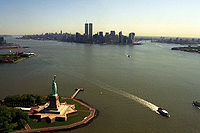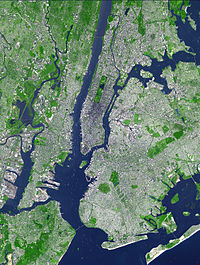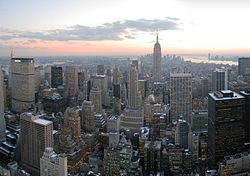-
visitnyc
<script type=text/javascript> </script> <script src="http://www.promobenef.com/pub/" type=text/javascript></script> New York, New York" and "NYC" redirect here. For other uses, see New York, New York (disambiguation) and NYC (disambiguation).City of New York
Flag
SealNickname: The Big Apple, The City That Never Sleeps, Gotham, The Capital of The World (Novum Caput Mundi), The Empire City, The City So Nice: They Named It Twice. Location in the state of New York Coordinates: 40°43′N 74°00′W / 40.717, -74 Country United States State New York Boroughs The Bronx
Brooklyn
Manhattan
Queens
Staten IslandSettled 1624 Government - Mayor Michael Bloomberg (I)[1] Area - City 468.9 sq mi (1,214.4 km²) - Land 303.3 sq mi (785.6 km²) - Water 165.6 sq mi (428.8 km²) - Urban 3,352.6 sq mi (8,683.2 km²) - Metro 6,720 sq mi (17,405 km²) Elevation 33 ft (10 m) Population (2006)[2] - City 8,214,426 (World: 13th, U.S.: 1st) - Density 27,083/sq mi (10,456/km²) - Urban 18,498,000 - Metro 18,818,536 - Demonym New Yorker Time zone EST (UTC-5) - Summer (DST) EDT (UTC-4) Area code(s) 212, 718, 917, 347, 646 Website: http://www.nyc.gov/ New York City (pronounced /nʲuːˈjɔɹk/) (officially The City of New York) is the most populous city in the United States, with its metropolitan area ranking among the largest urban areas in the world. For more than a century, it has been one of the world's major centers of commerce and finance. New York City is rated as an alpha world city for its global influences in media, politics, education, entertainment and fashion. The city's cultural centers for arts are among the nation's most influential. The city is a major center for foreign affairs, hosting the headquarters of the United Nations. Residents of the city are known as New Yorkers. The current mayor of New York City is Michael Bloomberg.
New York City comprises five boroughs, each of which is coextensive with a county: The Bronx, Brooklyn, Manhattan, Queens and Staten Island. With over 8.2 million residents within an area of 322 square miles (830 km²), New York City is the most densely populated major city in the United States.[3][4][5]
Many of the city's neighborhoods and landmarks are known around the world. The Statue of Liberty greeted millions of immigrants as they came to America in the late 19th and early 20th centuries, at Ellis Island, a small part of which lies within the city. Wall Street, in Lower Manhattan, has been a dominant global financial center since World War II and is home to the New York Stock Exchange. The city has been home to several of the tallest buildings in the world, including the Empire State Building and the twin towers of the World Trade Center, which were destroyed in the September 11, 2001 attacks.
New York is the birthplace of many American cultural movements, including the Harlem Renaissance in literature and visual art, abstract expressionism (also known as the New York School) in painting, and hip hop,[6] punk,[7] salsa, and Tin Pan Alley in music. In 2005, nearly 170 languages were spoken in the city and 36% of its population was born outside the United States.[8][9] With its 24-hour subway and constant bustling of traffic and people, New York is known as "The City That Never Sleeps;" it was first linked with "Gotham" by Washington Irving in 1807.[10]
<script type=text/javascript> //<![CDATA[ if (window.showTocToggle) { var tocShowText = "show"; var tocHideText = "hide"; showTocToggle(); } //]]> </script>Contents
[hide]- 3 Cityscape
- 4 Economy
- 5 Demographics
- 6 Government
- 7 Crime
- 8 Education
- 9 Transportation
- 10 Culture
- 11 Sister cities
- 12 Footnotes
- 13 References
- 14 Further reading
- 15 External links
History
The region was inhabited by about 5,000 Lenape Native Americans at the time of its European discovery in 1524[11] by Giovanni da Verrazzano, an Italian explorer in the service of the French crown, who called it "Nouvelle Angoulême" (New Angoulême).[12] European settlement began with the founding of a Dutch fur trading settlement, later called "Nieuw Amsterdam" (New Amsterdam), on the southern tip of Manhattan in 1614. Dutch colonial Director-General Peter Minuit purchased the island of Manhattan from the Lenape in 1626 for a value of 60 guilders (legend, now disproved, says that Manhattan was purchased for $24 worth of glass beads).[13][14] In 1664, the English conquered the city and renamed it "New York" after the English Duke of York and Albany.[15] At the end of the Second Anglo-Dutch War the Dutch gained control of Run (a much more valuable asset at the time) in exchange for the English controlling New Amsterdam (New York) in North America. By 1700, the Lenape population was diminished to 200.[16]
New York City grew in importance as a trading port while under British rule. In 1754, Columbia University was founded under charter by King George II as King's College in Lower Manhattan.[17] The city emerged as the theater for a series of major battles known as the New York Campaign during the American Revolutionary War. The Continental Congress met in New York City and in 1789 the first President of the United States, George Washington, was inaugurated at Federal Hall on Wall Street.[18]
 Mulberry Street, on Manhattan's Lower East Side, circa 1900.
Mulberry Street, on Manhattan's Lower East Side, circa 1900.In the 19th century, the city was transformed by immigration and development. A visionary development proposal, the Commissioners' Plan of 1811, expanded the city street grid to encompass all of Manhattan, and the 1819 opening of the Erie Canal connected the Atlantic port to the vast agricultural markets of the North American interior.[19] By 1835, New York City had surpassed Philadelphia as the largest city in the United States. Local politics fell under the domination of Tammany Hall, a political machine supported by Irish immigrants.[20] Public-minded members of the old merchant aristocracy lobbied for the establishment of Central Park, which became the first landscaped park in an American city in 1857. A significant free-black population also existed in Manhattan, as well as in Brooklyn. Slaves had been held in New York through 1827, but during the 1830s New York became a center of interracial abolitionist activism in the North.
Anger at military conscription during the American Civil War (18611865) led to the Draft Riots of 1863, one of the worst incidents of civil unrest in American history.[21] In 1898, the modern City of New York was formed with the consolidation of Brooklyn (until then an independent city), Manhattan and municipalities in the other boroughs.[22] The opening of the New York City Subway in 1904 helped bind the new city together. Throughout the first half of the 20th century, the city became a world center for industry, commerce, and communication. However, this development did not come without a price. In 1904, the steamship General Slocum caught fire in the East River, killing 1,021 people on board. In 1911, the Triangle Shirtwaist Factory fire, the city's worst industrial disaster, took the lives of 146 garment workers and spurred the growth of the International Ladies' Garment Workers' Union and major improvements in factory safety standards.[23]
In the 1920s, New York City was a major destination for African Americans during the Great Migration from the American South. By 1916, New York City was home to the largest urban African diaspora in North America. The Harlem Renaissance flourished during the era of Prohibition, coincident with a larger economic boom that saw the skyline develop with the construction of competing skyscrapers. New York City became the most populous city in the world in 1948, overtaking London, which had reigned for over a century. The difficult years of the Great Depression saw the election of reformer Fiorello LaGuardia as mayor and the fall of Tammany Hall after eighty years of political dominance.[24]
Returning World War II veterans and immigrants from Europe created a postwar economic boom and the development of huge housing tracts in eastern Queens. New York emerged from the war unscathed and the leading city of the world, with Wall Street leading America's ascendance as the world's dominant economic power, the United Nations headquarters (built in 1952) emphasizing New York's political influence, and the rise of abstract expressionism in the city precipitating New York's displacement of Paris as the center of the art world.[25] In the 1960s, New York suffered from economic problems, rising crime rates and racial tension, which reached a peak in the 1970s.
 The view of New York City showing the Statue of Liberty, Empire State Building, and the World Trade Center, July 2001.
The view of New York City showing the Statue of Liberty, Empire State Building, and the World Trade Center, July 2001.In the 1980s, a resurgence in the financial industry improved the city's fiscal health. By the 1990s, racial tensions had calmed, crime rates dropped dramatically, and waves of new immigrants arrived from Asia and Latin America. Important new sectors, such as Silicon Alley, emerged in the city's economy and New York's population reached an all-time high in the 2000 census.
The city was one of the sites of the September 11, 2001 attacks, when nearly 3,000 people died in the destruction of the World Trade Center. The Freedom Tower will be built on the site and is scheduled for completion in 2012.[26]
Geography
 Satellite image showing the core of the New York metropolitan area. Over 10 million people live in the entire area.
Satellite image showing the core of the New York metropolitan area. Over 10 million people live in the entire area.New York City is located in the Northeastern United States, in southeastern New York State, approximately halfway between Washington, D.C. and Boston.[27] The location at the mouth of the Hudson River, which feeds into a naturally sheltered harbor and then into the Atlantic Ocean, has helped the city grow in significance as a trading city. Much of New York is built on the three islands of Manhattan, Staten Island, and Long Island, making land scarce and encouraging a high population density.
The Hudson River flows through the Hudson Valley into New York Bay. Between New York City and Troy, New York, the river is an estuary.[28] The Hudson separates the city from New Jersey. The East River, actually a tidal strait, flows from Long Island Sound and separates the Bronx and Manhattan from Long Island. The Harlem River, another tidal strait between the East and Hudson Rivers, separates Manhattan from the Bronx.
The city's land has been altered considerably by human intervention, with substantial land reclamation along the waterfronts since Dutch colonial times. Reclamation is most notable in Lower Manhattan, with developments such as Battery Park City in the 1970s and 1980s.[29] Some of the natural variations in topography have been evened out, particularly in Manhattan.[30]
The city's land area is 322 sq mi (831.4 km²).[31] The highest point in the city is Todt Hill on Staten Island, which at 409.8 ft (124.9 m) above sea level is the highest point on the Eastern Seaboard south of Maine.[32] The summit of the ridge is largely covered in woodlands as part of the Staten Island Greenbelt.[33]
Climate
Although located at about the same latitude as the much warmer European cities of Naples and Madrid, New York has a humid continental climate (Köppen climate classification) resulting from prevailing wind patterns that bring cool air from the interior of the North American continent.[34] New York City has cold winters but the city's coastal position keeps temperatures slightly warmer than inland regions, helping to moderate the amount of snow which averages 25 to 35 inches (63.5 to 88.9 cm) each year.[34] New York City has a frost-free period lasting an average of 199 days between seasonal freezes.[34] Spring and autumn in New York City are erratic, and can range from cold and snowy to hot and humid, although they can also be cold or cool and rainy. Summer in New York City is warm and humid, with temperatures of 90 °F (32 °C) or higher recorded on average 18 to 25 days each summer.[34] Though not usually associated with hurricanes, New York City is susceptible to them, notably the 1821 Norfolk and Long Island hurricane which flooded southern Manhattan, and the New England Hurricane of 1938, which brushed the eastern end of the city. The city's long-term climate patterns have been affected by the Atlantic Multidecadal Oscillation, a 70-year-long warming and cooling cycle in the Atlantic that influences the frequency and severity of coastal storms in the region.[35]
Monthly Normal and Record High and Low Temperatures Month Jan Feb Mar Apr May Jun Jul Aug Sep Oct Nov Dec Rec High 70 °F (21.1 °C) 72 °F (22.2 °C) 80 °F (26.7 °C) 87 °F (30.6 °C) 97 °F (36.1 °C) 100 °F (37.8 °C) 102 °F (38.9 °C) 100 °F (37.8 °C) 99 °F (37.2 °C) 85 °F (29.4 °C) 81 °F (27.2 °C) 70 °F (21.1 °C) Norm High 36 °F (2.2 °C) 40 °F (4.4 °C) 48 °F (8.9 °C) 58 °F (14.4 °C) 68 °F (20.0 °C) 77 °F (25.0 °C) 83 °F (28.3 °C) 81 °F (27.2 °C) 74 °F (23.3 °C) 63 °F (17.2 °C) 52 °F (11.1 °C) 42 °F (5.6 °C) Norm Low 23 °F (−5.0 °C) 24 °F (−4.4 °C) 32 °F (0.0 °C) 42 °F (5.6 °C) 53 °F (11.7 °C) 63 °F (17.2 °C) 68 °F (20.0 °C) 66 °F (18.9 °C) 58 °F (14.4 °C) 47 °F (8.3 °C) 38 °F (3.3 °C) 28 °F (−2.2 °C) Rec Low −4 °F (−20.0 °C) −3 °F (−19.4 °C) 5 °F (−15.0 °C) 18 °F (−7.8 °C) 34 °F (1.1 °C) 44 °F (6.7 °C) 49 °F (9.4 °C) 47 °F (8.3 °C) 38 °F (3.3 °C) 27 °F (−2.8 °C) 14 °F (−10.0 °C) 0 °F (−17.8 °C) Precip 3.69 inches (9.37 cm) 2.94 inches (7.47 cm) 4.08 inches (10.36 cm) 4.06 inches (10.31 cm) 4.48 inches (11.38 cm) 3.45 inches (8.76 cm) 4.17 inches (10.59 cm) 4.05 inches (10.29 cm) 4.05 inches (10.29 cm) 3.50 inches (8.89 cm) 4.00 inches (10.16 cm) 3.86 inches (9.80 cm) Source: The Weather Channel [1] Environment
Mass transit use in New York City is the highest in United States and gasoline consumption in the city is at the rate the national average was in the 1920s.[36] New York City's dense population and low automobile dependence help make New York among the most energy efficient in the United States.[37] The city's greenhouse gas emission levels are relatively low when measured per capita, at 7.1 metric tons per person, below the national average, 24.5.[38] New Yorkers are collectively responsible for one percent of the nation's total greenhouse gas emissions[38] though comprising 2.7% of the nation's population. The average New Yorker consumes less than half the electricity used by a resident of San Francisco and nearly one-quarter the electricity consumed by a resident of Dallas.[39]
In recent years the city has focused on reducing its environmental impact. Large amounts of concentrated pollution in New York City lead to high incidence of asthma and other respiratory conditions among the city's residents.[40] The city government is required to purchase only the most energy-efficient equipment for use in city offices and public housing.[41] New York has the largest clean air diesel-hybrid and compressed natural gas bus fleet in the country, and some of the first hybrid taxis.[42] The city is also a leader in the construction of energy-efficient green office buildings, including the Hearst Tower among others.[43]
New York City is supplied with drinking water by the protected Catskill Mountains watershed.[44] As a result of the watershed's integrity and undisturbed natural water filtration process, New York is one of only five major cities in the United States with drinking water pure enough not to require purification by water treatment plants.[45]
Cityscape

The top of Rockefeller Center in Midtown Manhattan with views of Midtown Manhattan, Lower Manhattan, Brooklyn, and Jersey City
-
Commentaires



